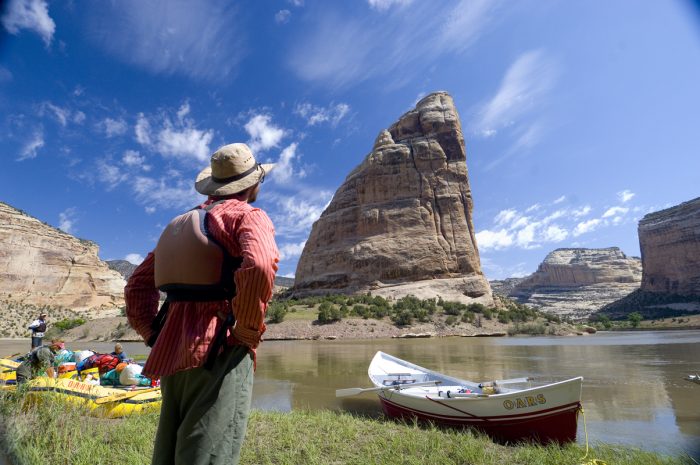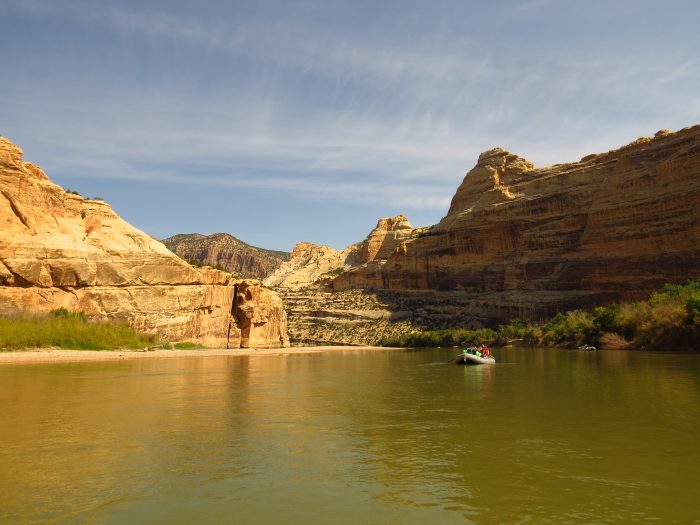Adventure.Travel highlights companies who are “doing good” by offering trips or experiences that are excellent examples of how adventure travel can be travel done right. Have you taken a trip with a company that's doing travel right? Nominate them for Doing Good.
The Green and the Yampa Rivers meet in a place called Echo Park in Dinosaur National Monument in Colorado. Yell into any of the sheer rock walls down there and you’ll hear your voice distinctly repeated four or five times. The Green River is dammed upstream by Flaming Gorge dam and its waters are clear and cold. The Yampa runs free and carries with it rounded river rocks, yellowish mud and the warmth of shallow streambeds. We’ve booked a rafting trip down the Green River, but we paddle and wade into the mouth of the Yampa: a bonus river whose wildness is irresistible.

A few windy miles downstream from the confluence of the Green and Yampa we stop for lunch on a sandy beach in a canyon so steep it’s already shady by early afternoon. Stefanie Wessel, one of our guides, circles the group while lunch is prepared and tells us that the beautiful place we’ve just rowed through was a planned reservoir. Across the river from where we’re standing, Stefanie took a picture of one of the bore holes that would have been used to anchor the 500-foot tall concrete Echo Park Dam that would have flooded the stunning confluence, the three days of scenic canyons that we’ve come through on the Green and equally as much of the scenery of the Yampa. Half of the 1,000-foot tall monolith called Steamboat Rock that the river floats by would be underwater.
There isn’t a dam at Echo Park and that’s why we’re here. But we’re also here to celebrate that the dam proposed in the 1950s was tabled due to the efforts of some of the world’s earliest environmental activists. There isn’t another dam on the Green River before it meets the Colorado, where they combine forces through Cataract Canyon. There isn’t another dam on the system at all until Lake Powell backs up behind Glen Canyon Dam, which went up as part of a compromise to save Echo Park.
O.A.R.S. Rafting has organized this trip as a benefit for the Colorado River and its tributaries -- of which the Green and the Yampa are big ones. The money O.A.R.S. makes off the trip will be donated to Save the Colorado, a nonprofit group that protects the Colorado River system by fighting irresponsible water projects that misuse, divert and impound the river, among other campaigns.
Gary Wockner is Save the Colorado’s Executive Director. On the first night of the trip he talks by firelight about his mission to protect and restore one of the world’s major rivers. He’s an impassioned and sometimes outraged activist with entrepreneurial tendencies, and PR-savvy. “We have to stop draining, diverting and piping this river,” he says in the dark while the Green chatters over rocks behind him. “The reservoirs are dropping and there’s no end in sight. It’s an exciting time. There’s a lot of doom and gloom, but there’s also an opportunity to make a consequential difference.”
It’s a lot easier to want to make a difference when you’re eating lunch at a proposed dam site on a trip that’s already blown your mind with both its gorgeous serenity and blood-pumping adventure.
Mark Dubois is also on this trip. A tanned and always barefoot man over six-and-a-half-feet tall with more salt than pepper in his hair and beard, Dubois rows a raft down the river that carries all our personal belongings. He seems like just another competent guide and I have to be pulled aside and told that he’s the guy who famously chained himself to a rock in the Slanislaus River in 1979. His innovative act of protest prevented a reservoir from being filled for only a few days, but his shackled feet were on the front page of newspapers around the nation and he changed the face of environmental activism, ushering in an era of awakening to some of nature’s greatest threats.
It’s easy to feel insignificant when you’re in a canyon that’s millions of years old -- and when you’re in the presence of a man who risked his life to save a river. But something as simple as taking a vacation can change the world too. Seeing a place for the first time and enjoying yourself is the first step toward making a difference. The next step is opening your ears and your heart and learning about a place -- letting the geology and the archaeology and the more recent conservation history really sink in.

O.A.R.S. guides are famous in the industry for their skill and professionalism, but the guides on this trip aren’t just oarsmen and cooks -- they’re also educators. They’re incredibly knowledgeable about the area and they are also willing to learn from their guests. On the last night of the trip, we go around the campfire circle and share a lesson the river has taught us -- guides and guests alike. Because we’re all here to learn and we will all become ambassadors once we get off the river of what we’ve been taught.
When Mark Dubois talks about rivers he puts his hand on his bare chest and touches his heart. His voice bears all of his emotion and talking about the dam site at Echo Park seems to physically cause him pain. Echo Park is the right name for this place. The fight seems so fresh here in sight of the bore holes of a would-be dam. The thought of being at the bottom of a reservoir is faint but crystal clear like the sound of your voice after bouncing off a few canyon walls.
O.A.R.S. offers 3 - 5 day trips on the Green River through the Gates of Ladore (and Echo Park and Split Mountain) from May through September.
Other organizations Doing Good for the world’s rivers: American Rivers, International Rivers, Friends of the River, Friends of the Earth



